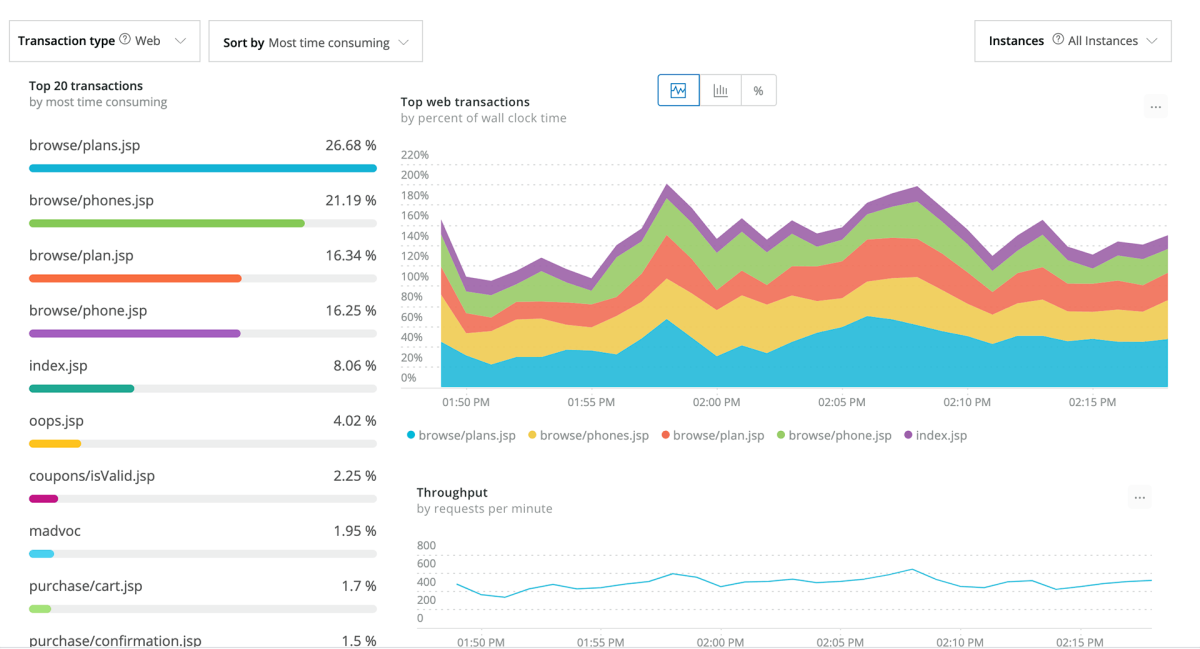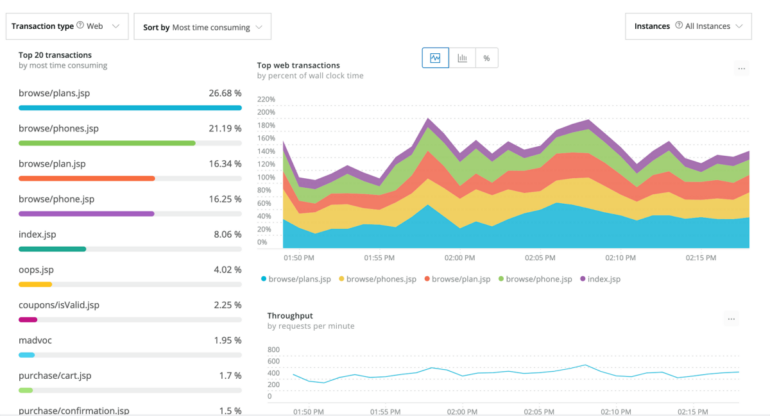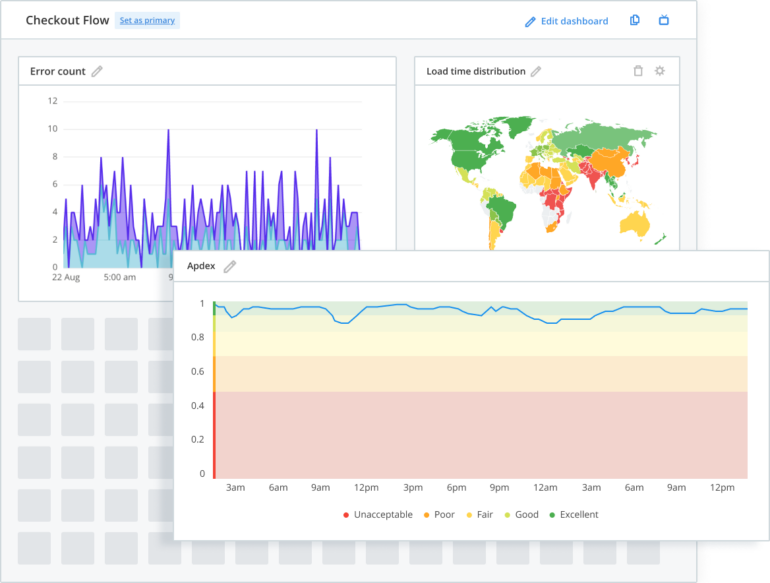
 technology
technology 
Application performance monitoring (APM) tools can help DevOps teams gain real-time insights into application health, detect and resolve issues rapidly, allocate resources efficiently, improve collaboration and more. This guide will break down the following top APM tools in terms of their features, pros, cons and pricing:
Jump to:
AppDynamics is a flexible and customizable all-in-one APM tool with powerful analytics. It’s ideal for software development teams looking to save time with automated error detection to ensure optimal user experiences.
Some of AppDynamics’ top APM features include:
AppDynamics supports multiple platforms, including Kubernetes, Microsoft Azure, AWS and more. The developer tool leverages machine learning to diagnose the root cause of application issues in real time, whether related to third-party APIs, code, etc. Journey maps within AppDynamics’ User Experience feature help developers optimize for customer satisfaction, while Business IQ promotes optimization by only focusing on the most relevant metrics and insights.
AppDynamics can spot security vulnerabilities in code within minutes and lets developers see which infrastructure components need to be optimized. Another feature worth mentioning is the DevOps tool’s customizable dashboards, which should be a hit with those in project management positions.
SEE: Top Log Management Tools for DevOps
AppDynamics’ pros include:
Installing and configuring AppDynamics could not be easier. The DevOps tool’s real-time monitoring lets developers quickly spot and resolve issues before customers are affected. The graphs and charts in AppDynamics are easy to understand, even for less technical users. And the customizable dashboard offers complete control for viewing valuable insights.
AppDynamics’ cons include:
While AppDynamics’ status as an all-in-one APM platform may attract some software development teams, others with more basic needs may see its long list of features as overkill. Along with those excessive features comes pricing that may be too high for teams with limited budgets, and that problem is made worse by the lack of a free plan. Another knock on AppDynamics is that it uses a lot of CPU and memory, which can negatively impact the performance of smaller systems.
AppDynamics offers free trials and four pricing plans. The programmer tool’s two plans that offer APM include:
The Premium Edition plan offers complete backend monitoring. Besides APM, it includes infrastructure and database monitoring, plus access to AppDynamics University. The Enterprise Edition plan adds business performance monitoring.

New Relic is an all-in-one observability platform with real-time application monitoring and analytics, AI-powered anomaly detection and integrations with over 600 popular third-party tools.
Some of New Relic’s highlighted features of its “APM 360” offering include:
New Relic’s APM 360 lets DevOps teams quickly view application health at every part of the stack and every development stage. You can instantly spot issues with error tracking and alerts, view dependencies, monitor golden metrics and more. Full-stack performance is visible via code-level insights from logs to infrastructure, allowing you to pinpoint the root cause of issues in a few clicks. With error user impact view, log patterns, distributed tracing to untangle complexity and more, New Relic makes it easier to debug faster.
New Relic also offers real-time user insights, letting developers see browser monitoring, critical transactions, synthetic checks, etc. And you can monitor business KPIs and SLOs in real time to pinpoint problems before they negatively impact your users. Preventative monitoring eliminates blind spots and monitoring gaps (missing alerts, vulnerabilities, uninstrumented services, etc.) and over 600 third-party integrations, including automatic instrumentation, offer ultimate extensibility.
SEE: Top DevOps Automation Tools
New Relic’s advantages include:
New Relic’s Standard plan that allows for one full-platform user at no cost is a significant plus. The APM tool is easy to set up, and its performance metrics and customizable dashboards are superb. New Relic also offers plenty of flexibility with its hundreds of third-party integrations.
New Relic’s disadvantages include:
New Relic’s cost for some of its paid plans may be more than what smaller teams can afford. Some of that potential high cost could be attributed to the fact that it gives you 30-plus capabilities (log management, errors tracking, etc.) within a single platform, which may seem like overkill for some strictly seeking APM features. And with so many features, New Relic may not only seem costly or excessive, but also complex when trying to complete simple tasks. Another New Relic gripe is its clunky user interface, which can be hard to follow.
New Relic’s pricing plans are as follows:
All of the programmer tool’s pricing plans include 100GB/month of free data ingest, unlimited basic users, hosts and CPUs, custom charts and non-quickstart dashboards, alerts/notifications and powerful querying capabilities. Full-platform users get access to APM and over 30 additional capabilities, such as errors tracking, log management, 600-plus integrations and more.

Raygun is an APM tool for customer-centric teams. It helps developers boost productivity by quickly spotting and fixing errors and improving application performance and stability to offer a better user experience.
Some of Raygun’s most noteworthy APM features include:
Raygun supports Ruby, .NET and Node.js. It simplifies the process of observing/understanding how your code is being executed, so you can pinpoint problems and fix them. Raygun’s visual trace views are expandable and make it easy to understand asynchronous threads, and you can view source code natively pulled directly from Bitbucket, GitHub, etc., within the APM tool.
Developers can use Raygun to quickly spot and prioritize issues in real time. They can then prioritize which issues need the most attention by filtering them by time, users impacted, average duration, time and frequency. You can create custom rules for issue detection and creation and remove unwanted URLs and method captures via code filtering to reduce noise. Raygun also has dashboards that provide entire teams with transparency so they can monitor optimization impact.
Raygun’s strengths include:
Thanks to its simple setup, it is easy to get started with Raygun. The APM tool is also easy to use and navigate, thanks to its modern and intuitive interface. Raygun’s usage-based pricing is another strength, as it is straightforward, comes via several pricing plans, and lets developers purchase extra reserved events for added flexibility.
Raygun’s weaknesses include:
Some users complained that Raygun’s customer service was not helpful. Another gripe is that its price has increased, and the current cost of the APM tool may be too high for some smaller development teams.
Raygun offers pricing plans to fit every software development team’s needs. The developer tool has crash reporting and real-user monitoring plans, plus the following for APM that come with a free 14-day trial:
Beyond those plans, developers can pre-purchase extra reserved events for added flexibility and savings. For example, 100,000 additional APM traces cost $80. All of Raygun’s APM plans come with a customizable overview page, method tracing, queries tracing, external API tracing, Apdex score, smart sampling, code filtering, automatic detection, notification, grouping of anti-patterns, advanced search/filtering, flamecharts, team interactions, source code integration and more.
There are several factors to consider when searching for the ideal APM software for your DevOps team. Price is important, especially if you are working with a limited budget. The APM tool should be user-friendly with an intuitive interface for less technical users, and it should have strong customer support, documentation and a large community for additional resources.
The ideal APM tool should support application monitoring across multiple environments (development, testing, staging, etc.), and it should support various frameworks, programming languages and technologies. Strong security and scalability are musts.
Some common APM features to look for include comprehensive real-time monitoring (infrastructure, databases, code, networks, servers, etc.), metrics and KPIs (error rates, latency, response times, etc.), root cause analysis, distributed tracing, alerts and customizable dashboards. Ideally, the APM software you choose will also integrate seamlessly with your existing DevOps toolchain.
For more information, check out our guide to 5 things to consider when choosing APM software.
The APM tools listed above are some of the top selections for DevOps teams. Before choosing one, make sure it fits your specific needs regarding pricing, user-friendliness, support and features.
24World Media does not take any responsibility of the information you see on this page. The content this page contains is from independent third-party content provider. If you have any concerns regarding the content, please free to write us here: contact@24worldmedia.com